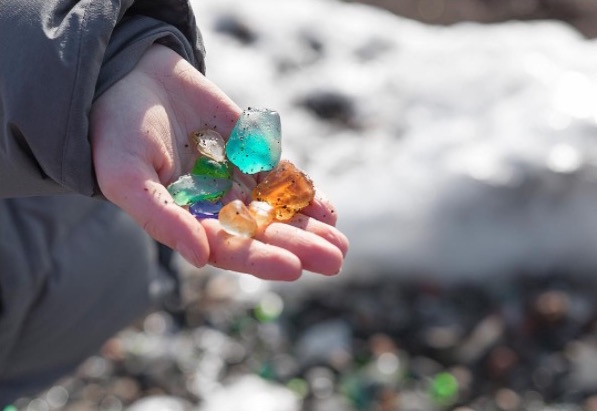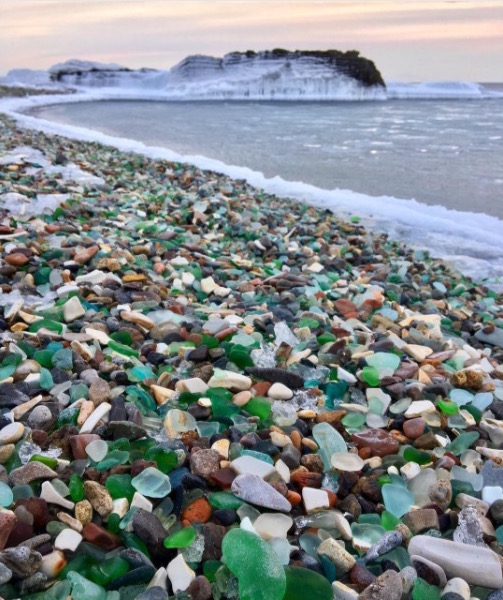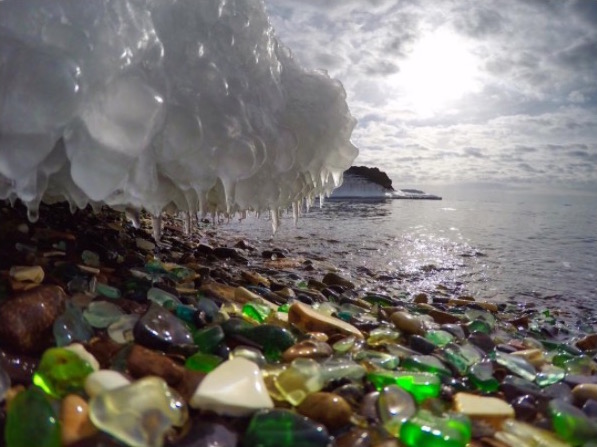Littering is bad. We'll say that right away because there's really never an excuse for pitching your garbage around all willy-nilly. It's rude, it makes public spaces look unattractive, and it can even be dangerous to animals and other humans. Unfortunately, some places seem to attract more dumping of garbage than others.
One of those places is near Russia's east coast, by the city of Vladivostok on the Sea of Japan. The beach has natural volcanic black sand, though today, you'd have to dig to see it.
That's because the beach is entirely covered in sea glass.
The coast used to be a dumping site for glass and porcelain back in the days of the Soviet Union. Truckloads of old bottles, dishes, and other glass and ceramic items were simply dumped on the sand and left.
That sounds pretty irresponsible these days, but nature has a funny way of cleaning up our messes in unexpected ways. After years of being ground down by sand, water and wind, they've become smooth and foggy, like little frozen jewels of seawater.
And they come in all kinds of colors, too. People from Russia and beyond come to comb through the dull-edged glass and porcelain pieces, and it's become so popular that it's actually now a protected place, watched over by the government. Glass Bay, as it's known, is also a popular place for swimming and other traditional beach activities.
As for the ecological issues, glass is far less damaging than plastic, which contains petroleum and can harm wildlife and ecosystems. The glass at Glass Bay will eventually get ground back down into what it started out as: sand.
[H/T: House Beautiful, Daily Mail]

At first glance, Glass Bay, or Steklyannaya Buchta in Russian, looks like an ordinary beach, but look closer, and you'll see thousands and thousands of glittering little gems in green, blue, and brown on the shore.

That's because this whole beach is covered in sea glass! It came from old bottles, as well as other glass and porcelain items that were dumped here throughout the 20th century.
For a long time, no one could access this beach because the sharp shards of glass and ceramic made it too dangerous.

But now, the sea, wind, and rain have ground them down and made them smooth.
Today, it's a popular tourist destination on Russia's east coast, and it's visited regularly during both summer and winter.

And when the waves roll in, they make a unique jingling noise as all those pieces of glass shift!

Glass Bay has become so popular that it's now a government-protected location, and people are charged entry. The fee goes toward maintaining the beach's upkeep.

In the summer, the colored glass looks striking against the beach's naturally black sand, which is the result of volcanic rock.
In the winter, they instead stand out from the white of the snow.

Today, the glass is worn down so smooth that it's safe enough to walk on, although wearing shoes does still seem prudent.

Visitors come from all over to make little sea-glass stacks, snap photos of especially pretty pieces, and take in the unusual landscape.

Some even take the time to spell out messages with the pieces of glass.
This one says "Vladivostok, Glass Bay" as a little memento of the visit.

And while dumping glass all over a beach might not have been the most environmentally friendly thing to do, glass is generally less ecologically damaging than plastic, a petroleum product.
When worn down, glass just becomes sand again.

During the winter, the glass gets mixed in with chunks of ice that form on the surrounding rocks, making for even more interesting textures and shapes.
It's no wonder this place is a favorite of photographers all year round.





